Metro’s hardest seat to get
February 13, 2014
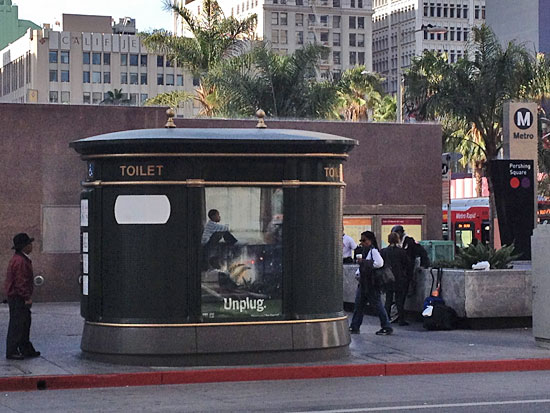
Despite a city-owned public toilet, Metro gets complaints of public urination at Pershing Square station.
As the saying goes, “When you gotta go, you gotta go.” That’s true whether you’re in a restaurant, a concert hall or riding a subway. But, despite public demand, installing restrooms at Metro stations is no easy business, according to the transportation agency, which recently undertook a study of the issue.
“We want to ensure that our customers have a great riding experience and have resources when a need arises, but there are a lot of elements that have to be factored in,” says Debra Johnson, Metro’s interim chief operating officer.
Although the agency has been grappling with the issue of public restrooms for years, Metro’s Board of Directors ordered a new look in November after residents near the Pierce College Station of the Orange Line busway in the San Fernando Valley complained that some riders were urinating in public. Among other things, Metro installed a video camera and monitored the area for 30 days, but couldn’t corroborate those complaints.
At the same time, the agency also was asked to take a look at the potential need for publicly-accessible restrooms at subway, light rail and bus rapid transit line stations throughout the system. The bottom line, according to a report that will be presented to the board later this month: Increasing the number of restrooms would not only be costly but could create crime problems unless security is enhanced at each location.
Currently, Metro maintains public toilet facilities at Union Station, the El Monte Bus Terminal and the Harbor/Gateway Transit Center—transportation “hubs” where staffers are present at all times. According to employee observations, restrooms in the busy Union Station were used consistently throughout the day. At the El Monte facility, five or fewer customers lined up during peak hours to use the free-standing automated public toilet, with less use at the Harbor/Gateway center.
The report notes that Metro employee restrooms are in place at Red Line subway stations but are opened to the public only in emergencies, as determined by Metro personnel. Generally, the report said, “customers are informed no public toilets are available,” even though it’s not uncommon for Red Line riders at the large 7th Street station to ask about the availability of public restrooms.
The agency, in its report, acknowledged the unpleasant realities that confront customers at some stations.
“Metro’s custodial staff report on-going issues with public urination and defecation at several of the rail stations as well as inside many of the station elevators,” the report said, adding that “other areas of public urination include the top side of subway station entrances such as Pershing Square, where loitering is common.”
But the agency pointed to the complexities of opening new restrooms with a cautionary tale of what happened when The W Hotel, located above the Hollywood and Vine Red Line station, agreed to provide a street-level public toilet as part of their contract with Metro.
According to Metro, the facility “became a magnet for the area’s homeless population which impacted the use by Metro’s customers. While open, the hotel developer was expending an average of $250 per day on paper products and had to replace three sinks, three mirrors and five toilet seats due to damage.” The restroom was labeled a public nuisance and was shuttered less than 4 months after its opening.
Johnson, Metro’s interim operations chief, notes that these kinds of problems are not limited to Metro operations. “It’s something that plagues us in today’s society considering the amount of people who don’t have access to facilities,” she said. “You could be walking around a city street and step around a puddle of urine. Collectively, I think there is an issue that needs to be addressed holistically.”
There’s also the price to consider. According to her department’s report, individual hard-wall toilets cost up to $700,000 to install and require regular stocking, maintenance and cleaning. In December, Robin Blair, the agency’s planning director, estimated that it would cost $70 million annually to maintain restrooms at every station. The agency estimates that the free-standing automatic public toilets would cost about $600,000 for two units, plus considerable custodial costs.
Then there are the public safety issues that come with adding restrooms to the system, thus creating a venue for illegal activity. “If you go anywhere in the world where people have tried this,” Blair said, “all of your problems are in the restrooms—crime, muggings, shooting up—all sorts of human degradation.”
“It’s up to the Board [of Directors] to decide what direction to take,” Johnson said. “For staff, our first and foremost mission is to ensure a safe environment for the riding public.”
No rider, of course, would argue with that goal. But a good number of them, like Renee Briddle, 38, who commutes 2 hours from Long Beach through downtown Los Angeles on the Blue and Red lines, think the status quo stinks.
Briddle was standing next to a small pool of urine the other day in a Civic Center station elevator. “It smells like that all the time,” she said, adding that such conditions are not uncommon, as Metro itself admits. One time, Briddle confided, she herself had an accident during one of her long commutes. “We need bathrooms,” she said, before hurrying on her way.
Posted 2/13/14
Always a holiday for pet adoption
February 13, 2014
Some people just have a knack for matchmaking. Elaine Seamans, for instance, has arranged hundreds of long-term relationships.
Last Halloween, she helped kindle more than 80 love affairs in a day at the county’s Baldwin Park animal shelter. Dozens more found the mate of their dreams at her Fourth of July and St. Patrick’s Day pet-to-person meetups.
And this week, the county Department of Animal Care and Control will be expanding the shelter volunteer’s signature love fest—a hearts-and-flowers pet adoption extravaganza that has found homes for nearly 100 stray and abandoned animals during the last three years.
“The idea was just to use the holidays to celebrate adoptions,” says Seamans, a 58-year-old Valley Village designer who has been organizing “My Furry Valentine” at the Baldwin Park shelter since early 2011. “But this has just gotten bigger and bigger every year.”
Colorful and festive, the event turns the shelter into a giant Valentine for one day, welcoming prospective pet owners with chocolate, gift bags, music and doggie kisses. This year, each of the county’s six shelters will hold a more or less elaborate version of the Baldwin Park celebration through the Valentine weekend, with the usual $50 adoption fee discounted to a heartfelt $14.
Holiday-themed adoption events have been a growing trend for some time at rescue nonprofits—the Found Animals Foundation has long held an annual “Happy Pawlidays” campaign in December, for instance, and the Best Friends Animal Society holds an “aCATemy Awards” tied to Oscar season. But until recently, it was unusual for a county shelter to initiate this kind of promotion, according to animal control officials.
The reluctance stemmed partly from an ambivalence about holiday adoptions. People are tempted to give pets as gifts, “and having a pet isn’t like getting a sweater that you can return—it’s a lifetime commitment,” says county Animal Care and Control Director Marcia Mayeda.
But, she added, county shelters were also slow to get on the holiday bandwagon because the shelter staff is consumed with day-to-day animal care duties. Only in the past decade, she says, has the county shelter system developed a volunteer program with the base and coordination to do fundraising and event planning, and “a lot of this is dependent on volunteers.”
Seamans, who has been volunteering with Best Friends and other rescue nonprofits since the 1998 death of her dachshund Quackers, had been donating her time for about a year at the Baldwin Park shelter when she suggested to shelter manager Lance Hunter that more could be done to find homes for the bereft dogs and cats in the shelter kennels. That, she says, is when she pitched the Valentine idea.
“It started out as just this little grassroots thing with just a couple of volunteers and some decorations,” says Hunter. But when their usual rate of eight or ten adoptions per day nearly tripled, he says, he took Seamans up on her offer to do more holiday events.
Since then, he says, other county shelters have begun hosting their own festive campaigns, and no holiday has been left behind when it comes to rustling up homes for pets at the Baldwin Park shelter. Last year, Seamans and her fellow volunteers organized events at Christmas, Valentine’s Day, the Fourth of July and Halloween, which Hunter said “topped the charts” at the shelter for holidays.
Among the attractions at the Halloween event were a fog machine and buckets where humans could bob for apples and dogs could bob for cocktail wieners, says Seamans. But “My Furry Valentine” is still the most elaborate promotion.
“Last year Elaine put frames and flowers around the outside of the kennels, and hung signs all over that said things like, ‘Your Best Friend Awaits’ and ‘Your Heart Is Missing Something’,” laughs Hunter. “We even had face painting and a ‘kissing booth’ built with some of the donations. And she got a young actor she knew to dress up as Cupid.”
“This year we’re getting a harpist,” adds Seamans. “This woman is donating her time in honor of her retriever, who passed away in January. Can you imagine? A harp player in the kennel! I’m dying to see how the dogs react to that.”
Mayeda says holiday events not only save pets’ lives, but also generate donations to the county’s Animal Care Foundation and improve morale among the county’s now-thriving ranks of volunteers.
They also put a friendlier face on the county system, says Seamans.
“A lot of people think shelters are scary,” she says. “They think they’re death camps, or where the ‘problem dogs’ go.”
But when people actually meet the pets, she says, they’re less concerned about their surroundings. All three of the dachshunds she has now—Quizzie, Fred and Doodles—were strays or abandoned. And after the 2011 event at which her teenaged actor friend Lou Wegner played Cupid, he returned to shoot a music video at the Baldwin Park shelter to benefit pet rescues.
In any case, she says, few things are more heartwarming than matching the perfect pet with the perfect family. Take, for instance, the note she got from a young mother who adopted a little dog for her 6-year-old son on a therapist’s recommendation last Valentine’s Day.
“Ohhhh, she is soooo good. Her name is Sassy,” the mother emailed. “Since the day we brought her, she let us know when to take her outside . . . She does love the bed, so we suckered her into sleeping with us or the kids. She is perfect for us—thank you.”
And that, she says, is just the product of one love story among hundreds.
“I tell people that the shelter is where your best friend is waiting,” says Seamans. “These animals are out there just waiting to show you how great you are.”
For more on “My Furry Valentine”, click here. And for more on the county’s other pet adoption programs, click here.
Posted 2/13/14
Jamzilla could be a monster
February 13, 2014
With officials keeping a close eye on the weather report and a couple of major sporting events, the gargantuan road-paving and lane-painting operation known as Jamzilla roars into action on the 405 Freeway this weekend.
In the days leading up to the 80-hour construction marathon, which runs from February 14-18, the weather forecast has been of more than casual interest. That’s because a cornerstone of the planned work—a costly, fast-hardening polyester paving process that allows the contractor to move far more quickly than would be possible with conventional paving materials—requires temperatures above 50 degrees (and below 100 degrees) to work properly. With a warming trend pushing overnight lows into the 50s, officials held a “go/no-go” meeting on Wednesday and decided to proceed with the effort, which is a key milestone in the long-running project to bring a 10-mile northbound carpool lane and other improvements to the 405.
But the thermometer hasn’t been the only preoccupation as Jamzilla approaches.
Officials also are worried about the human factor.
While L.A. sailed through two previous weekend-long “Carmageddons” in which the entire 405 was shut down, this time around may be a different story—paradoxically, because the freeway will actually have a couple of northbound lanes open during the daytime all weekend long, as well as all of the southbound lanes.
“When the freeway is closed, it’s easy for someone to make the decision. But with lane reductions, it means there’s always a chance. There’ll be some people who’ll just go there and see what happens,” said Edward Yu, who directs the city of Los Angeles’ Automated Traffic Surveillance and Control Center (ATSAC), which will be closely monitoring the flow of traffic as Jamzilla unfolds.
Also, unlike during either of the previous Carmageddons, there are a couple of big sports events scheduled in the area and expected to draw thousands of spectators: the Northern Trust Open at the Riviera Country Club, starting Thursday and running through Sunday, February 16, and the UCLA-University of Utah basketball game at Pauley Pavilion on Saturday.
The Getty Center, meanwhile, is open for visitors and showcasing a Queen Victoria film series this weekend, along with ongoing exhibitions. Another Sepulveda Pass institution, the Skirball Cultural Center, is offering its regular weekend lineup of programs.
Metro, which is running the 405 Project in conjunction with Caltrans, estimates it will need to reduce the regular traffic volume on the 405 by two-thirds just to keep things moving normally.
Anything else, they warned this week, could produce an “80-hour-long Sigalert.”
“If we don’t have enough people staying off the freeway, we will have long congestion lines. That’s guaranteed,” said Metro spokesman Dave Sotero. “One-and-a-half or two hours stuck on the freeway is no fun for anybody—and it could be even worse.”
He’s not just blowing smoke. A shorter, but otherwise similar paving operation last March, billed as “Son of Carmageddon,” caused lengthy traffic jams on the 405, Sepulveda Boulevard and beyond.
“We had northbound traffic backed up to the 90. The 10 was gridlocked in both directions leading to the 405,” recalled Sotero, who memorialized the occasion with a frame grab of all the red lines depicting clogged roadways on that day’s Caltrans QuickMap.
It doesn’t have to be that way this weekend.
Anyone who doesn’t need to drive should make it a car-free weekend, Metro advises. Those who do need to travel should steer clear of the construction zone and choose other freeways to get around.
And everybody who plans to be in motion anywhere near the 405 this weekend, including on the Presidents’ Day holiday Monday, should make it a point to be up to date on exactly where and when Jamzilla is taking place.
Full details are here, but in a nutshell, this is what’s happening:
The affected area is a 5.6-mile stretch of the northbound 405 between Getty Center Drive and Ventura Boulevard.
During the daytime hours, three northbound lanes will be closed, with two left open.
At night, all five northbound lanes will be closed.
The entire operation should wrap up in time for back-to-work traffic at 6 a.m. on Tuesday, February 18.
Unfortunately, this is not the final extended closure planned for the project, which is expected to be “substantially completed” and open for driving by summer.
A 55-hour closure of the southbound freeway is now in the planning stages. A date has not yet been set, but K.N. Murthy, Metro’s executive director of transit project delivery, said the upcoming extended shutdown is needed to work on retaining walls, sound walls, shoulder paving and lane restriping.
When the $1 billion-plus project finally reaches the end of the road, it will leave behind the 10-mile-long carpool lane, three rebuilt bridges and some dramatically reconfigured Wilshire “flyover” ramps, along with other improvements.
Another benefit, for transit riders, may in the offing as well.
When the new carpool lane opens this summer, Metro is considering using it to introduce a new rapid bus line between the San Fernando Valley and the Westside. If approved and funded by Metro’s Board of Directors, the new line could offer service from the Valley to Westwood beginning this summer, and would extend further south to connect with the Expo Line when the second phase of the light rail opens to Santa Monica in 2015.
Posted 2/13/14
Drought reigns in plant kingdom
February 6, 2014
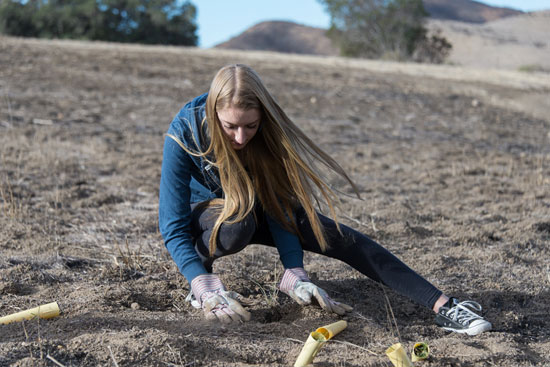
A volunteer helps plant one of 24,000 seedlings that have languished in a nursery because of drought conditions on hillsides charred by last year's massive Springs Fire. Photo/Steve Friedman
Last spring, after Sycamore Canyon was devastated by the earliest fire season in memory, Irina Irvine raced to protect the scenic landmark from an ancillary threat.
A restoration ecologist with the National Park Service, Irvine had been working to rid the Santa Monica Mountains National Recreation Area of destructive non-native grasses. Some of her most successful work had been in the hills around Newbury Park, where, in May, the fire had started.
Knowing that opportunistic plants could retake and wreck the natural ecosystem if she didn’t act quickly, Irvine prepared 24,000 native seedlings—elderberry and oak, coastal sage and purple needle grasses. Then she waited for the winter rains, when the sprouts could be planted.
And waited. And waited.
“Twenty-four thousand plants at $3 a plant, and several interns hired especially for this,” says Irvine. “And it hasn’t rained yet.”
Lawns aren’t the only landscapes that are starting to feel the effects of this year’s extreme drought. From street medians to coastal canyons, local naturalists say the shortage of water is having all sorts of unprecedented impacts.
At the Los Angeles County Arboretum and Botanic Garden, the absence of soil-cooling rain has tricked spring-blooming trees into blossoming as if it were April. In the San Fernando Valley, meanwhile, wildflowers are failing to germinate for lack of water.
In the Angeles National Forest, the drought has not only dried up natural springs but also emptied rain-catching “guzzlers”, small man-made reservoirs that provided a reliable fallback in past years for thirsty birds and wildlife. In the Santa Monica Mountains, the extreme water shortage has made historic oaks vulnerable to bark beetles and weakened even resilient trees such as eucalyptus.
“There’s been a lot of die-off in the native vegetation,” says Florence Nishida, a resident of Topanga Canyon and master gardener at the Museum of Natural History. “Landscaping at least has some source of water. But in the natural areas, the plants have gone since last March or April until now with hardly a drop of rain.”
Frank McDonough, botanical information consultant at the Arboretum, says the region is feeling a triple whammy—a years-long drought combined with a warmer-than-usual fall and winter and a high-pressure ridge that has cut off California’s usual dose of rain. Without a series of good, soaking downpours to cool down the soil, he says, the tree roots don’t realize it’s winter, and that, plus last month’s record heat, has left plants confused.
“Now our pink trumpet trees, which usually don’t bloom until March, are covered in blossoms, and the flowering apricots and nectarines are starting to bloom,” says McDonough, adding that more than a year or two of such unusual conditions can weaken trees and leave them vulnerable to disease and insects. Although it’s not necessarily good news, he says, “I expect the cherries will bloom earlier than normal, too.”
In wildflower country, on the other hand, the lack of rain is just depressing.
“It’s been pretty pitiful for the past two years, and it will probably be the same or worse this year,” says Lili Singer, director of special projects and adult education at the Theodore Payne Foundation, a Sun Valley nonprofit that operates an annual wildflower hotline.
For a good show, she says, wildflowers need at least one serious rain per month, starting in the autumn, so that they can establish themselves and produce plenty of buds before they start flowering. But with the exception of man-made seed-sowing initiatives such as Wildflowering L.A.—whose gardeners have been forced to water their supposedly drought-tolerant seedlings far more than expected—and the possibility that a few rare species will sprout in the wake of recent brush fires, Singer and other naturalists say they don’t have high hopes for this season.
“There’ll always be something for people to see,” says Singer, “but it will be a lot lower in the number of plants and the diversity.”
Nor are the wildflowers the only living things that are thirsty. In the Angeles National Forest, for instance, the county this week approved a grant to repair watering stations for wildlife and birds.
“This drought has just been real tough,” says John Forgy of the San Gabriel Valley chapter of Quail Forever, an organization that has offered to make the repairs as part of its work supporting wildlife. “And some of the young birds only eat insects, and there are no insects if there’s no rain.”
Irvine of the National Park Service says she has seen all these drought symptoms and more in the Santa Monica Mountains, where, in the plant world at least, “everything’s a little wacky right now.”
Vegetation, she notes, is vital in wildlands, not only because it’s habitat for wildlife, but also because it prevents erosion and counteracts global warming by sequestering carbon dioxide.
In areas like the mountains, where many species have evolved around drought, a dry year or two isn’t necessarily alarming.
“But you can only push so far before you reach a tipping point,” says Irvine. “When I see a big eucalyptus that’s been here for 50 years dying because there’s no water, that catches my attention. Pine trees are being hammered. And we are already seeing significant die-back in chaparral communities, and we don’t know if they’ll pop back up again if it rains, or if, when it’s gone, it’s gone.”
Particularly unnerving has been the effort to restore those 10 acres near the Wendy Trail head near Newbury Park at Rancho Sierra Vista in an area that was consumed last May during the freakishly early Springs Fire. Fueled by Santa Ana winds that had sucked the humidity in the air down to the single digits, the blaze swept from the canyons to the surf, consuming some 24,000 acres of drought-dried Los Angeles and Ventura Counties.
Among the casualties were some of the most scenic spots in the Santa Monica Mountains, including acreage on which Irvine had spent months trying to eradicate a particularly toxic and invasive strain of Australian bunch grass. The plan was to replant the area as quickly as possible with native seedlings that Irvine had carefully sprouted and set aside in a nursery.
“Normally what one does is wait for the first soaking rain of the year and then run, quick like a bunny, to get the plants in the ground as soon as the soil softens,” says Irvine. She had banked on an autumn planting. “But then when it didn’t rain in October, we were, like, ‘Darn it’,” she says. “And then no rain again in November. Darn it. And then December. And it was, ‘Are you kidding me?’”
The longer they waited, she says, the harder the earth got, making it even more difficult to transplant the seedlings that were in the nursery. And letting 24,000 seedlings die at $3 per seedling was not in the plan.
So when January came with no rain, she says, “We just said, ‘That’s it—we’re planting.’” Since January 17, Irvine says, she and a crew of interns and volunteers have been struggling to get the groundcover into the earth, which is so hard and dry that they’ve had to drill holes for the plants with a motorized augur.
“That’s 24,000 holes,” she says. “It’s been very slow going. We’ve only gotten about 9,500 plants into the ground, and we’ve been out there every day but Sunday and Martin Luther King Day.” Most recently, she says, she set aside $10,000 so she could water the plantings if necessary with a fire hose and a water tanker.
“If it rains substantially, of course, all bets are off,” Irvine says. “But from what I understand, just to get back to normal we’d have to have a couple of inches a day from now until about May.”
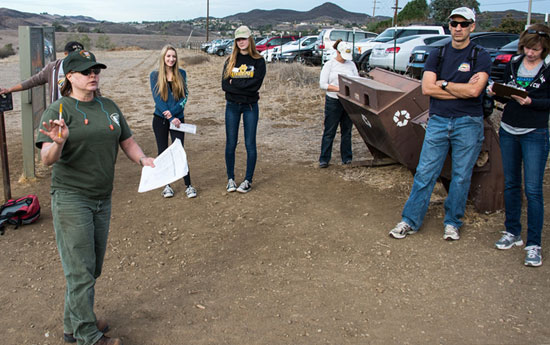
"You can only push so far before you reach a tipping point,” Irina Irvine says of the drought. Seen here in green, she gets the troops ready for planting seedlngs in the hard dirt. Photo/Steve Friedman
Posted 2/6/14
Not just a local hero
February 6, 2014
For 40 years, Rep. Henry Waxman has represented a wide swath of Los Angeles’ Westside. But the truth is that no single member of Congress has had a more far-reaching impact on the health and well-being of the entire nation than Waxman.
He championed legislation that led to cleaner air and water not only in L.A. but also in polluted cities across America. He was the driving force behind bills that restricted the use of pesticides and required food manufacturers to put those now-familiar nutrition labels on their products. He made sure that children in lower-income families had access to health insurance. He wrote the law that created the generic drug industry, saving consumers countless millions on their prescriptions.
And remember back in the mid-1990s, when the heads of the nation’s tobacco companies were collectively summoned to Washington for a televised hearing, during which they denied that their product was addictive? That landmark session was convened by Waxman, and it represented a turning point in the long and ultimately successful efforts to give the federal government more power to regulate tobacco.
Although Waxman is a proud liberal Democrat, a good number of those bills—and many others—were signed into law by Republican presidents, a testament to his mastery of the legislative process and his ability to build respect and consensus on both sides of the aisle.
With that legacy of accomplishment, it’s no wonder that, in recent days, there’s been an outpouring of praise for my friend and role model, the 20-term congressman. Last week, Waxman, surprised us all when he announced that he’d be retiring at the end of this year. At 74, he explained, it was time to begin the next chapter of his life. I can certainly understand that desire on the part of someone who has devoted his entire adult life to elective office. But I wish it wasn’t so.
Waxman’s departure will leave a huge void in Congress. Among many other things, his has been a powerful voice for the positive role government can play, especially in protecting the public health, whether you’re among the most fortunate of us or those struggling at the lower rungs of the economy. It’s not an exaggeration to say that his legislative work has saved millions of lives. He will surely be remembered as a huge idealist, but one with an unparalleled pragmatic capacity to turn those ideals into reality.
He also has been a great friend to Los Angeles County. In the mid-1990s, for example, when the county was confronting bankruptcy and the collapse of its health care system, Waxman stepped in to help secure the Clinton Administration’s help. In 2008, when federal officials wanted to sell off the Veterans Administration properties in Westwood, where so many deserving men and women have received assistance, Waxman again came to the rescue.
On a personal note, no public servant has taught me more about what it takes to bring about positive change in our society. Through his example, Waxman showed me that it’s not enough to have a vision. You must be willing to stay in the ring despite the long odds you may face. And when you’re knocked down, you get up and keep fighting for what you believe in.
As one of his longtime constituents, I’m grateful for his unmatched advocacy.
He’s going out a champion.
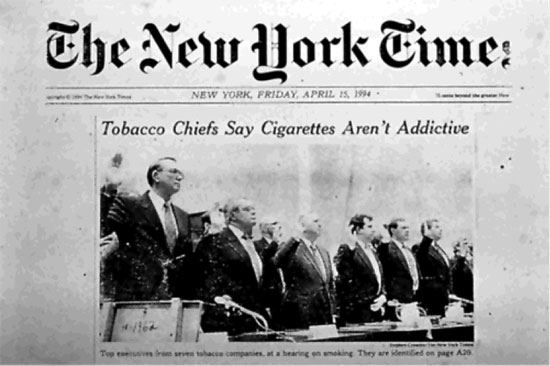
Waxman's tobacco hearings represented a turning point in bringing greater regulation to the industry.
Posted 2/6/14
We loved them yeah yeah yeah
February 6, 2014
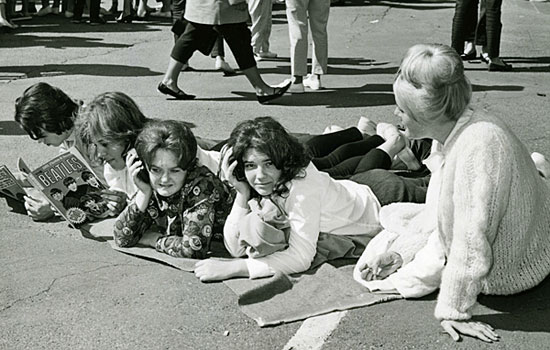
Fans mobbed the Hollywood Bowl for tickets to the Beatles' 1964 Los Angeles debut concert. Photo courtesy of The Music Center Archives/ Otto Rothschild Collection
It was 50 years ago this summer that four lads from Liverpool took the stage of the Hollywood Bowl, ushering in Beatlemania, Los Angeles-style.
Before the end of their 30-minute set on August 23, 1964, this much was certain:
A long-running love affair between the Beatles and Los Angeles was underway. Initially it involved mass hysteria, stealthy getaways, partying with local swells and celebrity hobnobbing on the Sunset Strip. Eventually it blossomed into “Breakfast with the Beatles,” a record label romance, a song, an uncomfortable meeting with Elvis in Bel-Air, even a Tower Records commercial.
At the same time, the Bowl itself was experiencing an electrifying new chapter in its fabled history, as a generation of screaming teenagers converged on the place where their parents had thrilled to popular stars like Frank Sinatra and classical music greats like Jascha Heifetz and Vladimir Horowitz.
Suddenly, it was a whole new ballgame.
“I think that night in 1964, that’s the most famous concert in American history, not counting Woodstock,” said Bob Eubanks, then a 26-year-old Los Angeles deejay and owner of two “Cinnamon Cinder” nightclubs, who produced the Beatles show by mortgaging his house for $25,000. “The boys at the Hollywood Bowl told us we couldn’t sell this thing out in one day, that it was physically impossible. Well, we sold it out in 3½ hours—without computers, by the way—and away we went.”

Paul McCartney backstage at the Bowl in '64. Photo courtesy of The Music Center Archives/ Otto Rothschild Collection
Along with thousands of smitten schoolgirls, stars like Lauren Bacall, Debbie Reynolds and Michael Landon turned out for the performance. Gossip queen Louella Parsons had to be relegated to the back benches—“she let us know about that for a long time,” recalled Eubanks, who went on to national fame as host of “The Newlywed Game.”
Ticket prices ranged from $3 to $7. Fans who couldn’t get in climbed trees around the amphitheater as “Twist and Shout,” “Can’t Buy Me Love” and “I Want to Hold Your Hand” rocked the Cahuenga Pass. After the final number, a cover of the Little Richard hit “Long Tall Sally,” the band was whisked away in a tiny compact car and was getting off the 101 Freeway at Sunset Boulevard before the audience knew what hit them. “The kids still thought they were there and they ruined two limos out back,” Eubanks said.
From his vantage point as a deejay at KRLA, the city’s top rock ‘n’ roll radio station at the time, Eubanks had known for months that something big was on its way.
“Suddenly, there were these four guys from England who just changed the world musically,” he said. “Our phones just started to ring off the hook…It started the night they did the Ed Sullivan show, quite frankly. When we heard they were coming to America, the country started to really buzz.”
This year, the buzz is back. With the 50th anniversary of the group’s first appearance on the Sullivan show taking place this Sunday, February 9, there’s no shortage of magazine covers and think pieces analyzing the British Invasion. And the Hollywood Bowl, where L.A.’s adventures in Beatlemania began, this week announced that it is marking the occasion with three “The Beatles’ 50th at the Bowl” concerts in August. (Those aren’t the only ‘60s flashbacks in store at the Bowl, by the way; the summer schedule also includes performances of the musical “Hair”—complete with “simulated drug use” and “brief nudity.” Check out the complete Bowl schedule here.)

Fainting girls went with the territory. Photo courtesy of The Music Center Archives/ Otto Rothschild Collection
Dave Stewart (of Eurythmics fame) will be “ringmaster and musical director” for the August 22, 23 and 24 Beatles shows at the Bowl, which will include yet-to-be-announced special guests and a re-creation of their original musical set from 1964.
Eubanks said he’d like to take part in the shows if possible. As the 50th anniversary approaches, he has also reached out to Paul McCartney. In an email reply, read by Eubanks in a telephone interview this week, the former Beatle demurred about his availability on the anniversary date but sent along reminiscences of the “heady days of our early trips to L.A.” and this message to fans:
“It was a fantastic time for us and I still have many memories of the things that we got up to. It was great to play the Hollywood Bowl even though our music was completely drowned out by the screams of our lovely fans.”
The Hollywood Bowl Museum is gearing up for the occasion as well. Carol Merrill-Mirsky, museum and archives director for the museum and the Los Angeles Philharmonic, which operates the county-owned Bowl, has commissioned a 3-D model of the Beatles in concert. It will be showcased this summer along with the small cache of Beatles memorabilia—including a copy of Eubanks’ contract for the 1964 concert—that’s on regular display.

Tickets for the 1964 show sold out in 3½ hours. Photo courtesy of The Music Center Archives/ Otto Rothschild Collection
She also has been combing through old pictures from the Music Center archives to put on display—although there are not a lot of images in the collection from that initial concert. She thinks that’s because, aside from Eubanks, few saw the magnitude of what was about to unfold that night.
“He had an instinct that it was going to be huge but nobody else did. Nobody. Certainly the Bowl didn’t, and the fact that we have so few photographs is proof that it was not a big deal. But it was a big deal to the fans—to those teen fans.”
Despite the frenzy among local teens, not everyone was thrilled to see the Fab Four arrive in Los Angeles in 1964. “They wanted to stay at the Ambassador, but the Ambassador didn’t want ‘em,” Eubanks remembered. A house in Bel-Air, complete with “a pool and the whole nine yards,” was lined up instead.
On the night of the concert, a busload of marshals showed up at the Bowl, ready for deployment to “protect the neighbors up in the hills.” Eubanks thought it was a great idea until he realized he was going to be footing the bill.
As a result, he said, he ended up making only about $4,000 on the 1964 concert. But Eubanks, who went on to produce all of the Beatles’ L.A. concerts—two performances at the Hollywood Bowl in 1965 and a 1966 show at Dodger stadium—did “quite well, thank you” on the later gigs.
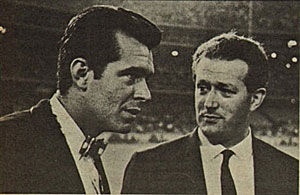
Eubanks, with Beatles publicist Tony Barrow at Dodger Stadium in 1966, witnessed the band's evolution.
He also had the priceless experience of seeing the band’s three-year evolution—from “wide-eyed and curious” in 1964 to seasoned “road warriors” in 1965 to “very difficult” in 1966.
After the last-ever Los Angeles show in 1966, he remembers arguing with John Lennon in the Dodgers’ dugout after the original getaway car failed to make it out of the stadium.
“We got into it pretty good with John down there because he wanted to get to a party. ‘You’ve gotta get us out of here.’ We went nose to nose. And finally I said, ‘I’ll get you out of here.’ We went upstairs and put them in the back of an ambulance.”
The driver “was nervous as heck. He drove right down through 40,000 people…he hit a speed bump and the radiator fell out of the ambulance.”
Finally, they reached a rendezvous point with an armored car that was intended to complete the trip away from the stadium. But it was mobbed with teenage girls and the Beatles’ escape seemed to be foiled again.
“And all of a sudden, I have no idea where they came from, the Hells Angels showed up,” Eubanks said. “They circled the armored car, the kids backed off, and the Hells Angels led the Beatles from Dodgers Stadium. And that was the last time I saw the Hells Angels or the Beatles.”
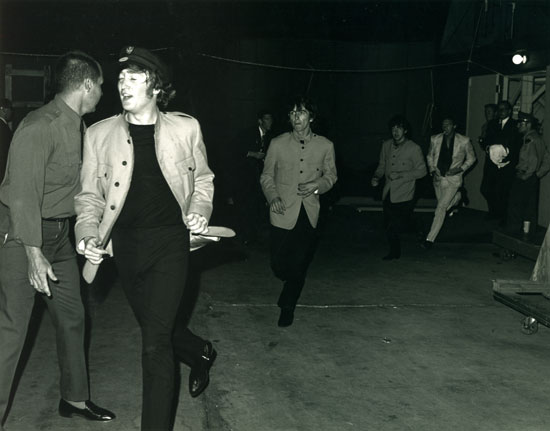
Running into the Bowl in 1965. Photo courtesy of The Music Center Archives/ Otto Rothschild Collection
Posted 2/6/14
Trial by fire for Metro’s new top cop
February 6, 2014
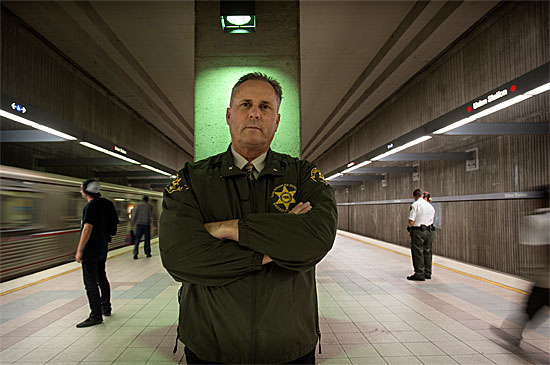
Commander Claus is a SWAT veteran with a dramatically different set of new responsibilities at Metro.
Sheriff’s Commander Michael Claus became the new head of security for Metro’s bus and rail system on January 6. He knew the job would be complicated, but he couldn’t have predicted what would happen next.
A week after he started, on the morning of January 13, a fatal stabbing took place on the Red Line. It was the second killing in the history of the line, and the widely-publicized tragedy forced Claus to throw out his playbook.
“If you can imagine taking a big, giant eraser board that has everything laid out nice and neat, and then just take both hands and move everything around? That’s what it was like,” Claus said.
Luckily, his police instincts kicked in.
“When something like this occurs, you have two issues,” Claus said. “One, you have to solve the problem, find out who did it and hopefully have an arrest—which we did. Second, as an administrator you have to look at what we did, whether we could have prevented it and what we can do now to prevent it in the future. You have to wear two hats.”
The first part comes naturally for Claus, 52, who has more than 33 years of experience as a Los Angeles County Sheriff’s Department deputy, SWAT team member and SWAT commander. The administrative part is new territory.
“I left my dream job,” Claus said. “When I was a deputy at SWAT, I always said I wanted to be the first person to work on the unit and then go back and command the unit. And I was the first person to do that. Eight months later I get a phone call and the sheriff asked me to come over here and command this bureau. You don’t tell the sheriff ‘no.’ ”
After decades on patrol, Claus now finds himself doing much of his work from behind a desk.
“This is completely different from anything I’m used to,” he said.
One immediate challenge has been managing public perceptions in the wake of the stabbing, which raised safety concerns among many transit riders. Claus said those fears are understandable, but they’re distorted by this isolated event, in part because of how the media covered it. “It’s like a plane crash,” he said. “After a plane crash they tell you it’s the safest transportation mode in the world. But when there’s a murder, the news doesn’t do that.”
According to Sheriff’s Department statistics, “Part 1” crimes, which include homicide, rape, aggravated assaults and theft crimes, are exceedingly rare on Metro’s system. On the Red Line, for example, there were only 3.8 of those crimes per million riders in 2013. Violent crimes are even rarer, with property offenses like the theft of electronic devices accounting for the majority of that number.
Other than a police station parking lot, Metro is one of the worst places to commit a crime. Perpetrators rarely get away because closed-circuit TV cameras are always watching and camera-equipped passengers serve as witnesses, Claus said. The suspect arrested and charged with the Red Line stabbing was identified using footage from train and station cameras.
“If Metro’s system were a city, it would be the safest city in the country,” said Duane Martin, who manages the agency’s work with the Sheriff’s Department. “People tend to focus on occurrences that are out of the ordinary. When something like this happens on Metro, it stands out.”
Still, even one crime is too many for the people charged with protecting the riding public. Claus is already brainstorming improvements. One idea he’s considering is assigning teams of deputies to the same couple of stations or bus stops every day to create a transit version of community policing, enabling the deputies to get familiar with regular patrons—and potential troublemakers. Currently, deputies are generally assigned to regions that they are familiar with and moved around as needs dictate. Claus wants to focus them on smaller beats to give them a proprietary interest in keeping each area safe.
Both Claus and Metro’s Martin are seeking to improve fare enforcement, a major priority for the agency. Currently, deputies are responsible for making sure that people pay their fares and for issuing citations to violators. But Claus believes that sworn deputies’ skills are better used elsewhere.
“From what I’ve seen so far, I think it’s a waste of a resource for a deputy sheriff to check TAP cards,” Claus said. “Deputy sheriffs should be performing law enforcement functions, not revenue functions.” He added that it’s tough to recruit good people because trained police don’t want to spend their days checking cards.
Claus envisions using Metro employees and security assistants to check fares instead, while deputies patrol for safety—a quick call away if a conflict arises. Martin agrees. “When they are on a train and they have both hands checking tickets, they aren’t looking for quality of life issues,” Martin said. With each sworn deputy costing the agency about $210,000 per year and civilian employees costing about a quarter of that amount, “you want to get the best bang for your buck.”
Claus also wants to improve how his team communicates with the public. “We are going to start educating people about how not to be victims,” he said. Part of that involves common sense steps like securing purses and electronic devices. However, in the case of a verbal or physical confrontation, he said, the best course of action is to be a good witness and stay out of the way. “It’s hard for me to say ‘don’t get involved’ because I’m one of those guys that would get involved,” Claus said. But, as a law enforcement officer, he pointed out, “I also carry a gun.”
Suspicious activity, of course, should be reported by dialing 911 or calling the Sheriff’s Department. But there’s a catch. That only works on buses and above-ground light rail; there is currently no cellular or wireless internet service on the subway. There, passengers should look for emergency phones at either end of each rail car and in the stations, or try to find a Sheriff’s deputy or a Metro employee. The agency is in the process of installing wireless service underground, but the effort will not be completed for about a year. “All we have is radio down there,” Martin said. “Having telephone service will be a godsend for us.”
The Sheriff’s Department acts as an independent contractor with Metro, which is paying the department about $83 million for the current fiscal year. The contract expires in June, and Martin expects that the next contract, which must be put through a competitive bidding process, will include new performance standards and different fare enforcement requirements. The current contract started in July, 2009, before TAP cards and gate latching were implemented. Back then, fare enforcement was done mainly by checking individual paper tickets.
Commander Claus hasn’t been on the job long, but he’s adapting quickly to his new position, which also involves delicate political situations he hasn’t faced before.
Because Metro’s territory cuts across many political boundaries, moving resources around can be touchy. “One of the lines may go through one county Supervisor’s district and one goes through another. They might ask ‘why are you taking resources from my district?’”
On top of that, there’s inherent friction between law enforcement’s duty to investigate crimes and Metro’s mission to reliably transport millions of people from place to place on time. Stopping rail lines for lengthy investigations can be a complex undertaking. “You have to find that happy medium,” Claus said.
It all adds up to a brave new world for a man who decided to become a police officer at age 5 while watching cop shows on television. Like any good administrator, his first task will be to take stock of what he already has.
“I love a challenge,” Claus said. “It’s like taking over a factory that makes cars. First you are going to learn how to make the car, and then you’re going to see if you can do anything better.”
Posted 2/6/14
Some straight talk from new sheriff
January 29, 2014
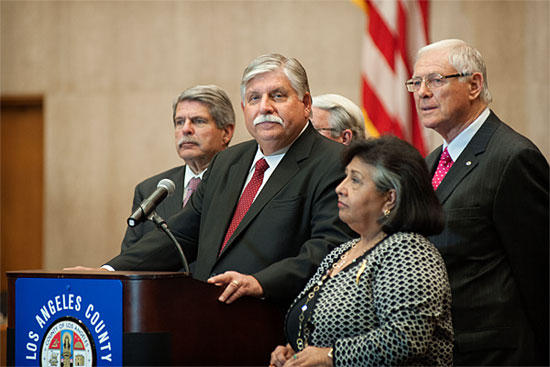
Interim Los Angeles County Sheriff John Scott (center) is flanked by supervisors as he meets the press.
After 36 years on the Los Angeles County Sheriff’s Department—with jobs ranging from street patrol in Lakewood to overseeing the country’s largest jail system—John Scott did not like what he was seeing.
“I thought the direction of the department was taking a turn that I did not want to be part of,” Scott recalled. “I saw diminished accountability. I saw fragmentation within the department. I saw some people who did not represent the best interests of the department.”
Scott said he felt “an obligation to talk to the sheriff.” But after voicing his concerns, he said he did not believe he had the support he needed “to fight the good fight.” So in March of 2005, he retired.
But on Tuesday afternoon, nearly nine years later, he was back, standing before a bank of TV cameras in the downtown Hall of Administration. He was flanked by members of the Board of Supervisors, who had just selected him as the department’s interim sheriff. His mandate: to keep the troubled agency moving swiftly toward reform until the election of a new sheriff either in the June primary or November runoff.
Scott will replace Sheriff Lee Baca, who officially retires on Thursday at noon. Baca’s departure comes after more than two years of steady controversy that eroded the agency’s reputation, including the recent indictments of 18 current and former members of the department for alleged brutality in the jails and obstruction of justice.
With no incumbent on the ballot, the race to succeed Baca has turned into one of the most heavily contested in the department’s recent history. At the same time, Baca’s unexpected retirement put enormous pressure on the Board of Supervisors to find an interim sheriff who would aggressivelyimplement reforms recommended in 2012 by the blue-ribbon Citizen’s Commission on Jail Violence. “We didn’t want a caretaker,” said Supervisor Zev Yaroslavsky. “And we didn’t want someone distracted by campaigning for the job.”
Scott seemed to be a good fit on both counts.
Besides his years of service in Los Angeles, Scott has spent the past 5 years as the undersheriff in Orange County. There, he has helped the agency recover from a sensational corruption scandal involving ex-Sheriff Michael Carona, who ended up in federal prison for witness tampering. Scott was recruited by Carona’s successor, Sandra Hutchens, a former division chief in the Los Angeles County Sheriff’s Department. (Scott, who is taking a leave of absence from his Orange County post, will return there after Baca’s replacement is sworn in.)
In an interview Wednesday with a writer for Supervisor Yaroslavsky’s website, Scott said his first—and top—priority will be to make sure everyone on the command staff is “in alignment” with the mission of bringing substantive reform and accountability to the department so they can effectively communicate it throughout the organization.
“I need to know that I have their complete buy-in,” he said. “If I don’t, then there’s going to be changes. I’m not bashful about that.”
Scott said he’s optimistic that changes in policy and direction can come quickly. But he said he’s realistic about the deeper cultural changes. “That’s a time-tested kind of process,” he said. “It’s like turning that big aircraft carrier.”
In Orange County, he said, some members of the department who resisted change ended up leaving the department because “it was heading down a different path—not one they chose. What you’re left with are people who have bought in.” He said he suspects the same thing could happen in Los Angeles.
For help in his new job, Scott has turned to a former colleague, retired Field Operations Chief Neal Tyler, who’ll return as an executive officer.
“I need immediate assistance from someone I know and trust,” Scott said of Tyler, who oversaw operations in Malibu/Lost Hills, Crescenta Valley, Altadena and Lancaster, among other places. Scott said that Tyler, like him, “had a great deal of difficulty with things that were going on.” Tyler left the department about a year ago, Scott said.
Scott said one of the challenges they’ll face is keeping the political race for sheriff from creating divisions and distractions in the rank and file. The current field includes two high-ranking insiders, as well as two former members of the department who’ve maintained alliances on the force. He said he will make it clear to the two inside candidates that “the operation of the Sheriff’s Department is Priority One and that their campaigns are on their own time…The mission is what we need to focus on, not the candidates. We need to keep this ship righted.”
On a personal level, Scott said his wife, Alice, strongly supports his return to the department so he can finally press ahead with the reforms he wanted to initiate before he felt compelled to leave. She’s a former sheriff’s captain, who retired in 2010, and, like him, did not like what she saw.
“She is one of those who watched internally and then from a distance and felt very disappointed and frustrated,” Scott said, adding: “I want to bring back the department’s premiere status.”
Posted 1/30/14
Scratching a $33,413-a-month itch
January 29, 2014
We all have our baggage. Take the 70,000-plus dogs and cats that arrive each year at Los Angeles County’s animal shelters. Think they come alone? Think again.
“Ohhhhh,” laughs John Gonzales, a former animal control officer who is now president of the nonprofit Los Angeles County Animal Care Foundation. “Ticks and fleas.”
“All it takes is for one dog to show up with a couple and within 20 minutes they all have them,” says Gonzales, whose organization supports the county shelters through fundraising for spay-and-neuter programs, pet adoptions and other animal welfare initiatives.
“And then if you adopt the animal out, even if you give him a quick bath, people will come back complaining that not only does their new pet have fleas, but their whole house is infested. It’s not a pleasant situation. And that’s not including what the poor animal goes through.”
That scenario used to play out with dispiriting frequency at county shelters, where intake workers rarely had the time or budget to do more than spritz flea spray onto the itchier-looking arrivals, and where managers periodically had to call pest control companies in to treat the kennels.
“The ticks were especially hard to get rid of,” says Animal Care and Control Director Marcia Mayeda, ”because they can jump off the animals and hide, even in the crevices of broken concrete.”
For the past three years, however, the county has been deploying a secret weapon, donated through the Foundation from a pet products manufacturer.
“Now, when animals are brought in, they get a physical, vaccinations and a spot treatment of flea medication,” says Mayeda, crediting a $33,413-per-month, in-kind gift of Frontline Plus by the Georgia-based Merial Corp.
“We still obviously clean and disinfect our kennels daily but we no longer have to bring in people to treat them for ticks and fleas.”
The product donation, which is not unusual between manufacturers and pet advocacy organizations, is part of Merial’s “Partners in Protection” community outreach program to shelters and veterinarians.
Nikkia Starks, director of consumer marketing at Merial, says the program has connected with more than 50 shelter clinics across the country to help protect pets from fleas, ticks and heartworm disease while educating shelter staff and pet owners on the importance of preventative pet health care. The Los Angeles County gift, she adds, is among its larger ones.
Though some municipalities have agreed to tout Merial’s products in return for their donations, the county’s use of the product carries no such conditions. Rather, Gonzales says, Merial donates supplies of Frontline Plus to the Foundation, which then passes it on to the county’s seven animal shelters. “We’re kind of the middle man,” he says.
The foundation’s nonprofit status, he adds, offers the manufacturer a tax break without obligating the county to serve as a marketing partner. Mayeda says Merial approached the county in 2011 with the offer. Recognizing the brand, she in turn took it to Gonzales, she says.
Such spot treatments—so called because the pesticide is applied on a spot of skin at the back of the animal’s neck so the pet can’t accidentally ingest it—typically keep pets flea-free for up to 30 days at a time, but tend to be pricey. Frontline Plus, for instance, retails in pet stores for up to $18 per dose.
“We never used it before because we couldn’t afford it,” says Mayeda. “But our flea and tick problem has gone from an ongoing concern to pretty much nonexistent, and it has made a big difference in the overall health of the animals, and in customer service as well.”
Posted 1/23/14





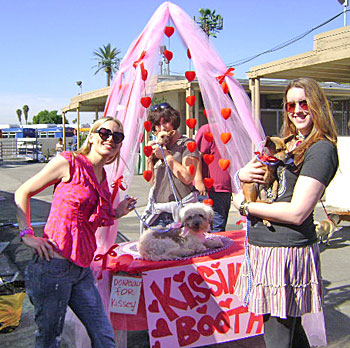


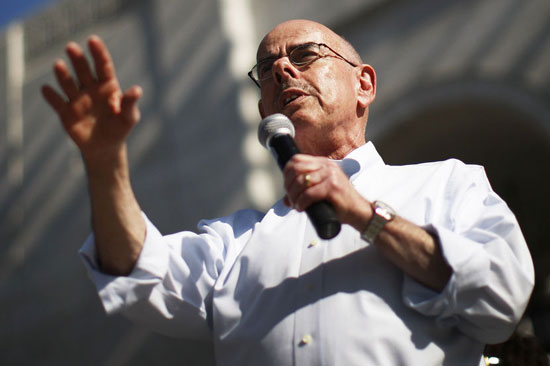

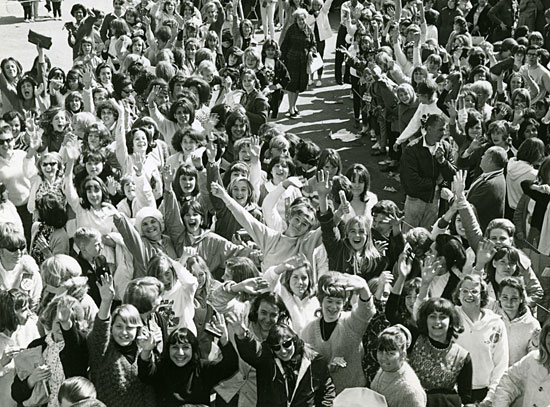
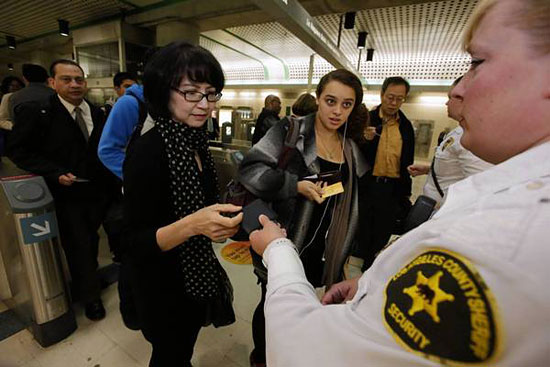






 Check for the latest closure information
Check for the latest closure information








